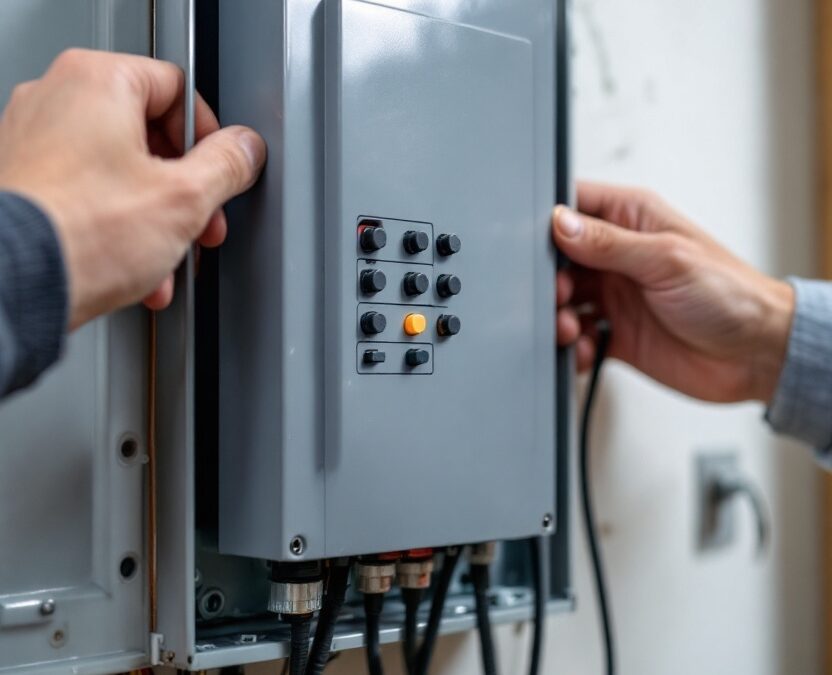Installing a whole house surge protector requires careful attention to safety and proper technique. You'll need to start by gathering crucial tools, including insulated gloves, safety glasses, and electrical testing equipment. The installation involves turning off main power, mounting the device near your electrical panel, connecting wires to bus bars, and installing a dedicated circuit breaker. While DIY installation is possible, working with high-voltage equipment demands extensive knowledge of electrical systems and safety protocols.
Key Takeaways
- Turn off main power at the electrical panel and verify all circuits are de-energized using a voltage tester for safety.
- Mount the surge protector near the main breaker panel and install a dedicated double-pole circuit breaker per manufacturer specifications.
- Connect surge protector wires to appropriate bus bars, ensuring proper wire routing and secure connections to prevent loose terminals.
- Replace panel cover and restore power, then verify proper operation by checking indicator lights on the surge protection device.
- Schedule professional inspection to confirm installation meets NEC code requirements and obtain necessary permits for compliance.
What Is a Whole House Surge Protector
A whole house surge protector serves as your home's primary line of defense against dangerous power surges and voltage spikes that can damage or destroy expensive electronics and appliances.
This device installs directly into your main electrical panel and monitors incoming voltage levels continuously, providing thorough surge protection for your entire home's electrical system.
When voltage levels exceed safe thresholds, it'll instantly divert excess electricity through a grounding system.
You'll find advanced models equipped with monitoring systems that track voltage levels and protection status.
For ideal electrical safety, the system works alongside your existing circuit breakers and can handle surge capacities between 40kA to 200kA.
Required Tools and Safety Equipment
Before tackling any electrical installation project, you'll need to gather specific safety equipment and tools to guarantee proper protection and successful completion.
Proper tool organization and equipment selection are essential for a safe, efficient installation process.
Essential Safety Gear:
- Insulated boots and electrical safety gloves
- Safety glasses and flame-resistant clothing
- Hard hat for head protection
Required Tools and Equipment:
- Wire strippers and different screwdrivers
- Pliers and cable clamps
- Testing equipment (multimeter, voltage tester)
- Mounting hardware and labeling materials
- Circuit analyzer and manufacturer's test module
Step-by-Step Installation Process
Now that you've gathered your safety equipment and tools, installing a whole house surge protector requires methodical attention to detail and proper sequencing.
Different surge protector types present unique installation challenges, but following proper steps guarantees peak protection for your home's electrical system.
Begin the installation process with these critical steps:
- Turn off the main power and verify circuits are de-energized with your voltage tester.
- Mount the surge protector near the main breaker, guaranteeing minimal wire bends.
- Connect wires to the appropriate bus bars and install a dedicated double-pole breaker.
After securing all connections and replacing the panel cover, test the system's operation by checking indicator lights.
Safety Precautions and Code Requirements
Proper safety protocols and strict code compliance form the foundation of whole house surge protector installations.
You'll need to follow NEC Article 110 safety measures, including de-energizing power and using insulated gloves and safety glasses during installation.
Code compliance requires Type 1 or Type 2 SPDs with at least 10kA nominal discharge current, per NEC 2023 requirements.
You must install these devices adjacent to service panels, and only licensed electricians can perform the work.
Remember to obtain necessary permits and schedule inspections to verify your installation meets all local regulations and maintains equipment warranties.
Cost Breakdown and Value Analysis
Understanding the costs of whole house surge protection requires examining several key components.
You'll find that professional installation typically ranges from $300-$500, with protection types varying in price based on their capabilities and placement location.
When evaluating installation benefits against costs, consider these critical factors:
- Basic Type 2 protection starts at $200-$450 installed
- Premium Type 1 systems run $250-$800 installed
- Labor costs average $50-$100 per hour
You'll gain extensive protection for your entire electrical system, potentially saving thousands in equipment damage while avoiding the need for multiple point-of-use suppressors.
Maintenance and Testing Guidelines
To optimize the effectiveness of your whole house surge protector, regular maintenance and testing are essential for keeping your electrical system secure. You'll need to conduct regular inspections every 3-6 months, checking for cracks, discoloration, and proper indicator light function.
| Maintenance Task | Frequency | Key Actions |
|---|---|---|
| Visual Inspection | Every 3-6 months | Check for damage, verify LED status |
| Performance Testing | After storms/annually | Test voltage, response time |
| Professional Check-up | Yearly | Thermal scan, grounding verification |
Remember to schedule professional performance testing annually and keep detailed maintenance logs. Don't forget to clean your unit with compressed air every six months, and always maintain proper environmental conditions, keeping temperatures below 75°F with moderate humidity levels.
Professional Vs DIY Installation Considerations
While installing a whole house surge protector might seem like an achievable DIY project, the high-risk nature of working with your home's electrical panel makes professional installation the safest choice.
The professional benefits far outweigh DIY drawbacks when you consider safety, warranty protection, and code compliance.
Here's why you should choose professional installation:
- Licensed electricians guarantee proper integration with your electrical panel while maintaining safety standards and insurance coverage.
- You'll avoid potentially costly mistakes that could damage expensive appliances or void manufacturer warranties.
- Professional installations typically cost $200-$500, which is minimal compared to repair costs from DIY errors.
Conclusion
You've now got the knowledge to make an informed decision about whole house surge protection for your home. Whether you choose professional installation or DIY, remember to follow local codes and safety protocols carefully. Regular maintenance and testing will guarantee your system continues protecting your valuable electronics and appliances. With proper installation and upkeep, you'll have reliable protection against power surges for years to come.
